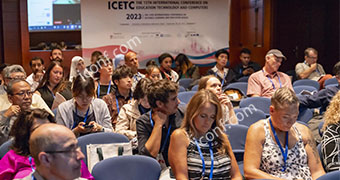Academic Conference Paper Abstract Template
A typical conference paper abstract includes the following sections:
1. Title of the Paper
- Format: The title should be clear, concise, and descriptive. It should reflect the core theme or research question of your paper.
- Example: "Exploring the Impact of Artificial Intelligence on Healthcare Diagnostics"

2. Background/Introduction
- Purpose: Briefly introduce the context and importance of the topic. Why is this research significant, and what gap in the existing literature does it address?
- Length: This should be 2–3 sentences.
- Example:
"Artificial Intelligence (AI) is rapidly transforming various industries, including healthcare. Despite the increasing adoption of AI in diagnostics, there remains a lack of comprehensive studies on its practical benefits and challenges in real-world healthcare settings."
3. Objectives/Aims of the Study
- Purpose: State the main research question or objective of your paper. What are you trying to achieve, investigate, or prove through your study?
- Length: 1–2 sentences.
- Example:
"This study aims to examine the role of AI in enhancing diagnostic accuracy in healthcare, focusing on its effectiveness in detecting early-stage diseases and improving patient outcomes."
4. Methodology
- Purpose: Describe the research methods or approach you used to gather data and conduct your analysis. This may include experimental design, data collection techniques, or analytical tools.
- Length: 2–3 sentences.
- Example:
"A mixed-methods approach was employed, combining quantitative data analysis of diagnostic accuracy rates with qualitative interviews of healthcare professionals using AI-powered diagnostic tools."
5. Key Findings/Results
- Purpose: Highlight the main results or findings of your research. What did your study reveal, and how does it contribute to the field?
- Length: 2–3 sentences.
- Example:
"The study found that AI-powered diagnostic tools significantly improved diagnostic accuracy in early-stage cancer detection, with an accuracy rate of 92%, compared to 80% for traditional methods. Additionally, healthcare professionals reported increased confidence in making diagnosis decisions."
6. Conclusion/Implications
- Purpose: Summarize the key conclusions of your research. What are the implications of your findings for the field, and how might they influence future research or practices?
- Length: 1–2 sentences.
- Example:
"These findings suggest that AI has the potential to revolutionize healthcare diagnostics by improving accuracy and efficiency. Future research should explore the scalability and ethical considerations of AI implementation in different healthcare contexts."
7. Keywords
- Purpose: List 3–5 relevant keywords that capture the main themes of your paper. These help improve searchability and help the conference organizers categorize your paper.
- Example:
"Artificial Intelligence, Healthcare Diagnostics, Early-stage Disease Detection, Mixed Methods, Healthcare Technology"
Full Example Abstract
Title: "Exploring the Impact of Artificial Intelligence on Healthcare Diagnostics"
Background:
Artificial Intelligence (AI) is rapidly transforming various industries, including healthcare. Despite the increasing adoption of AI in diagnostics, there remains a lack of comprehensive studies on its practical benefits and challenges in real-world healthcare settings.
Objectives:
This study aims to examine the role of AI in enhancing diagnostic accuracy in healthcare, focusing on its effectiveness in detecting early-stage diseases and improving patient outcomes.
Methodology:
A mixed-methods approach was employed, combining quantitative data analysis of diagnostic accuracy rates with qualitative interviews of healthcare professionals using AI-powered diagnostic tools.
Key Findings:
The study found that AI-powered diagnostic tools significantly improved diagnostic accuracy in early-stage cancer detection, with an accuracy rate of 92%, compared to 80% for traditional methods. Additionally, healthcare professionals reported increased confidence in making diagnosis decisions.
Conclusion:
These findings suggest that AI has the potential to revolutionize healthcare diagnostics by improving accuracy and efficiency. Future research should explore the scalability and ethical considerations of AI implementation in different healthcare contexts.
Keywords: Artificial Intelligence, Healthcare Diagnostics, Early-stage Disease Detection, Mixed Methods, Healthcare Technology
Tips for Writing an Effective Abstract
- Be Clear and Concise: Avoid jargon and overly complex sentences. The goal is to provide a snapshot of your research that is easy to understand.
- Stick to the Word Limit: Most conferences have a word limit for abstracts (usually between 250–300 words). Adhere to this limit and ensure each section is well-balanced.
- Highlight Novelty: Emphasize the originality of your research and how it contributes to advancing the field.
- Revise and Edit: Review your abstract multiple times to check for clarity, grammar, and spelling errors. Ask a colleague to review it for feedback.
Conclusion
Crafting a compelling and effective abstract is essential to your success in submitting papers for academic conferences. By following this template, you can ensure that your abstract clearly communicates the key aspects of your research while adhering to academic standards. Whether you are submitting to a conference hosted on iconf.com or elsewhere, this structure will help you present your work in a concise and impactful way.
For more resources on conference submissions, visit iconf.com and get started with your next academic paper today!


